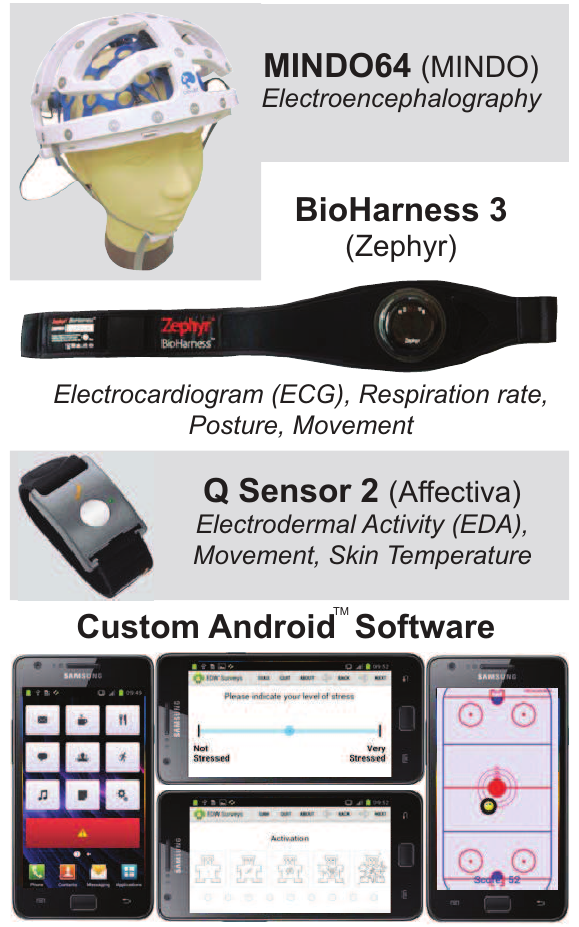Real-World Neuroimaging Technologies
By Kaleb McDowell, Chin-Teng Lin, Kelvin S. Oie, Tzyy-Ping Jung, Stephen Gordon, Keith W. Whitaker, Shih-Yu Li, Shao-Wei Lu, and W. David Hairston
NOTE: This is an overview of the entire article, which appeared in Volume 1 (2013) of IEEE Access.
Click here to read the entire article.
While there have been many demonstrated successes in real-world neurotechnologies during the last three decades, it is argued that there may be fundamental differences in how the human brain functions to control behavior when it is situated in virtual environments as opposed to highly controlled laboratory environments. This article discusses the efforts of a joint government-academic-industry team, supported by the U.S. Army Research Laboratory (ARL), to take an integrative, interdisciplinary, and multi-aspect approach to translate current technologies into devices that may enhance our ability to assess brain activity in real-world scenarios. The authors stress the need to expand the capability of neuroimaging beyond the lab and into real-world environments where natural human, task, and environmental interactions can be studied. In doing so, this will dramatically impact the rise of novel brain-computer interaction technologies (BCITs). BCITs are potentially revolutionary technologies that are moving human-systems communication beyond the mere transmission of information between man and machine and toward the capability for mutually-derived data analysis, interpretation, and prediction.
“Brain imaging … will become even more powerful when high resolution neural data are gathered from participants moving freely and interacting in natural ways,” according to the Executive Office of the President, National Science and Technology Council.
In large part, this research is limited by the technological gap between the neuroimaging tools that currently exist and the tools needed to appropriately conduct neuroimaging research in real-world environments. While significant progress has been made more recently, true real-world neuroimaging will require further development in four critical technology areas: Neuroimaging Hardware, including multi-aspect sensors arrays, power, and on-board processing capabilities that meet the wearability and usability requirements for real-world research and application; Algorithms, addressing issues ranging from signal-to-noise ratios to multi-aspect sensor integration; Interfaces that both facilitate highly multidisciplinary research amongst scientists from varying fields of study, and enable effective data collection by naïve participants; and Experimentation, Testing, and Validation including novel paradigms for neuroimaging under uncertainty and technologies for validating new hardware and algorithms.
Currently, ARL and its partners, National Chiao Tung University (NCTU) in Taiwan and DCS Corporation are collaborating to implement a first-of-its-kind, wearable, high density, real-world neuroimaging system for studying stress and fatigue in the workplace (see Figure below). The prototype, Stress and Fatigue Neuroimaging (SFN) System V1.0, is made up of an Android device, a Samsung Galaxy S3 in the current implementation, which monitors, records, and synchronizes data streamed from three physiological monitoring devices.

Prototype Real-World Neuroimaging System. Four components are illustrated, an Android device for data collection and integration, a laboratory grade, dry electrode, wirelesss, high resolution EEG system, a Bioharness 3, and an Affectiva Qsensor. Android screenshots depict some examples of activity logging components, such as a start/stop logger (left), two self-assessment surveys (middle), and a visuomotor continuous tracking task (right).
BCIT systems will have to be cost-effective, safe and robust across a wide variety of environments. They will need to operate consistently and reliably within an environment that could be physically damaging to a sensitive unit, and have the ability to properly deal with noise and artifacts that will occur within the BCIT application. The systems will also have to be usable by anyone; simple to set-up and troubleshoot. The real-time processing requirement is perhaps the most critical constraint on BCITs. Finally, neuroimaging for BCIT purposes is almost exclusively framed around a previously established target signal. As a result, BCIT systems can be designed efficiently to detect the target signal at the cost of flexibility or maximal data availability.
ABOUT THE AUTHORS
Author bios and photos are included in the article.






